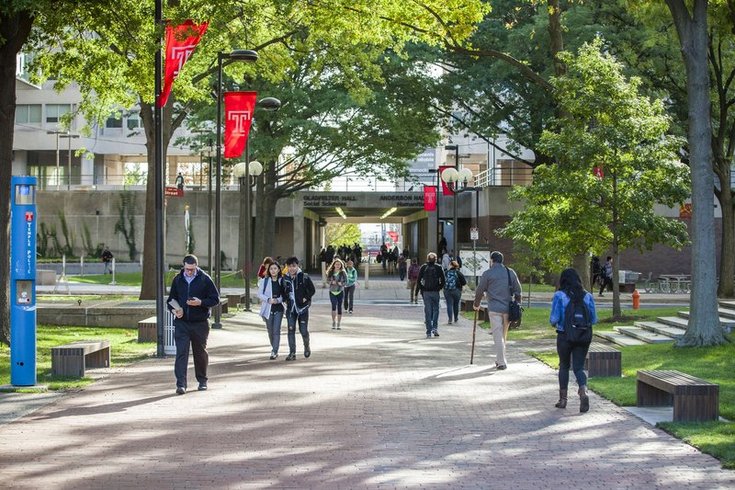
September 24, 2023
 THOM CARROLL/for PhillyVoice
THOM CARROLL/for PhillyVoice
Temple University is one of several local schools that saw a significant bump in its ranking on the new U.S. News and World Report Best Colleges list, thanks to a revised methodology used to calculate how schools rank.
Several schools in the Philadelphia region fared well in the latest U.S. News and World Report "Best Colleges" list, with some seeing big improvements in their rankings thanks to recent changes in how the list is calculated.
Five area colleges ranked among the top 100 best U.S. schools on the 2023 list, which was published last week. As usual, the University of Pennsylvania was one of the nation's most well-regarded schools, this time landing at No. 6 on the national university's list, and Penn's Wharton School finished No. 1 on the list of the best business programs in the country. Villanova University place 67th nationwide. At No. 89, Temple University broke the top 100 for the first time, while Drexel University just narrowly made it at No. 98 in a tie with six other universities, including Rutgers University—Camden.
Princeton University held the No. 1 spot in the country for the sixth straight year.
Other notable local schools on the Best Colleges list include Thomas Jefferson University at No. 142 nationally, and La Salle University at No. 201. St. Joseph's University finished eighth on the Regional Universities North list and Arcadia University in Glenside, Montgomery County, was further down that same list at No. 69. Swarthmore College and Bryn Mawr College both made the list of Most Innovative Schools, at spots 15 and 18, respectively.
This year, there were some surprises as a result of changes to the underlying ranking methodology used by U.S. News. These changes – which generally put greater emphasis on outcome measures, like graduation rates and social mobility, while deemphasizing things like admission rates and alumni giving – caused some colleges to climbing 50 spots or more compared to their 2022 rankings.
In the Philadelphia region, specifically, at least nine schools benefited from the new ranking methodology. Temple University jumped up 32 spots from last year's list, tying for 89th with Southern Methodist University in Dallas, Texas. West Chester University rose 40 spots to No. 209; Rowan University jumped 30 spots to No. 163; Penn State rose 17 spots to No. 60; the University of Delaware jumped 13 spots to No. 76; and Rutgers-Camden climbed 29 spots up to No. 98 while Rutgers main campus in New Brunswick jumped 15 spots to the 40th best school on the list.
"Temple's improved ranking is all the more satisfying because it was not something we focused on or sought to accomplish this past year," acting Temple University president was JoAnne Epps said in a blog post on Monday. (Epps died suddenly on Tuesday after falling ill at a university event.) "We simply remained committed to Temple's core priorities — access, the student experience, student outcomes, diversity and the quality of our faculty—and this dedication to our mission has been rewarded."
Other colleges and university's saw their rankings decline with the methodology changes. Villanova University dropped 16 spots on the nationwide list. Immaculata University, a private Catholic college in East Whiteland, Chester County, also slid down the list, dropping 31 positions on that list to spot No. 280.
While U.S. News often tweaks its school ranking algorithm, this year's changes are said to be the most dramatic adjustments to its methodology in over 40 years, according to the New York Times.
To update its ranking methodology, U.S. News added some new factors, eliminated others and adjusted the weight of certain datapoints that it was already using. New ranking factors include the number of first-generation students at a school, how likely its graduates are to earn more than those without a college degree and how productive and well-cited its faculty is when it comes to published research.
The new methodology also puts increased weight on the graduation rate of students who received federal Pell grants, the school's student-faculty ratio, and a metric known as graduation rate performance.
The list no longer tracks metrics like graduating class size, high school class standing and the rate of alumni giving at a given institution – factors that often tilted rankings in favor of wealthier schools. U.S. News and World Report published a blog post breaking down the changes in detail.
The methodology adjustments come after years of criticism and skepticism from some schools about the list, which U.S. News and World Report has published annually since 1983. Over the last 40 years, the list has become highly influential for parents and students researching colleges and somewhat controversial amongst the institutions themselves. Some have questioned the accuracy, fairness and overall value of the list, which some believe has an outside influence on higher education decision-making.
Some universities have withdrawn from direct participation in the annual ranking calculation, while others have gone to great efforts to influence the outcome. Last year, Rutgers University's business school was accused of falsifying data in an attempt to boost the school's ranking on the list. Rutgers denied the accusation. Meanwhile, former Temple University business school dean Moshe Porat was sentenced to 14 months in federal prison last year for submitting fraudulent information in an effort to inflate the school's rankings.